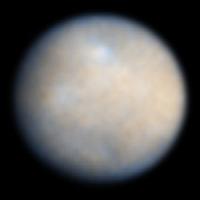
Ceres as seen by Hubble Space Telescope
In September, we posted about a recent study that concluded that up to half the water on our planet is older than the sun. Scientists now speculate that the existence of water may be far more common in the universe than previously thought. Some of that water may be fairly close to home, at least in astronomical terms. The dwarf planet Ceres, the largest object in the asteroid belt, which lies between the orbits of Mars and Jupiter, may contain more water than our planet Earth.
This dwarf planet may contain more freshwater than Earth
Using the Herschel Telescope, the European Space Agency has detected water vapor on Ceres, the largest and roundest object in the asteroid belt. And it just may have a whole lot of it.
For the very first time, water vapor has been detected on an object in the asteroid belt, providing definitive proof that Ceres, the dwarf planet, contains both an atmosphere and a surface of ice. If that ice were to melt, scientists postulate, the tiny planet only 590 miles in diameter may possibly contain more freshwater than all of Earth….
Scientists have long thought that Ceres — once known as a large asteroid and first spotted back in 1801, but renamed a dwarf planet due to its immense size in 2006 — contained a surface of water, ice, and various minerals. The findings published Wednesday have finally confirmed this. “This is the first time water vapor has been unequivocally detected on Ceres or any other object in the asteroid belt,” said Michael Kuppers, lead author of the Nature paper and a member of the ESA in Spain.

Without sunlight?
Maybe Microbes or the creature from space.
Watch out, they’ll want to move here.
Yes, I read it a day or two ago, but I have my doubts.